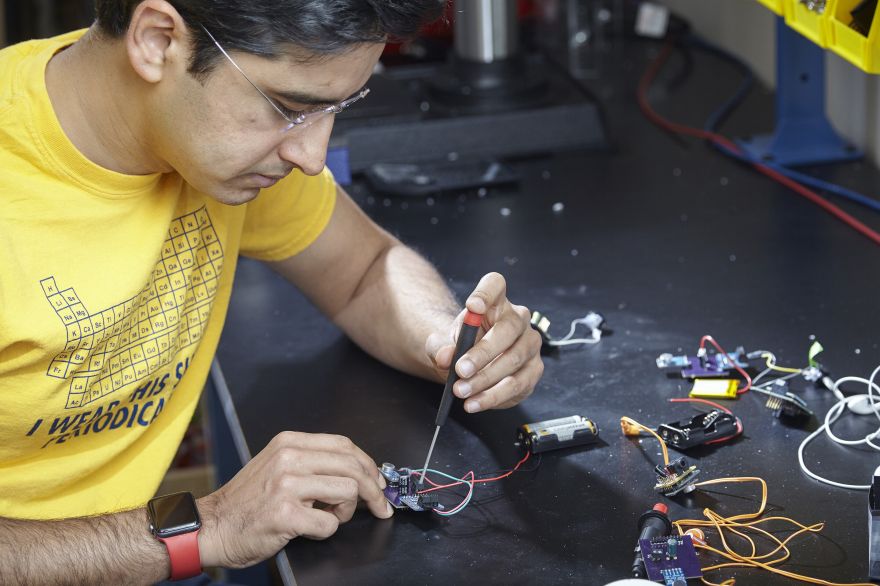Neatorama |
- The Anatomy of A Fall Guy
- Savage Baby Hippos
- It’s A Squirrel Playing Piano
- The Nintendo Game That Originally Had Profanity
- He Asked For Friends Because He Was Lonely. Now He Has Hundreds From Around The World
- Who Invented The Selfie?
- An Affordable Hearing Aid
- This Device Can Collect Energy From The Breeze You Make
- Man Rides Kid’s Bike For Charity
- A Guide To Making Your Readers Laugh
- A 10,000 Year Warning
- Can You Find the Cat?
- A 20th-Century Jonah and the Whale Tale
- The Hot Chocolate Effect
- Inside the Arctic Greenhouses Where the Summer Sun Never Sets
| Posted: 26 Sep 2020 09:43 PM PDT
What are Fall Guys? Some thought that they are humans inside a suit. They thought wrong. Fall Guys developer Mediatonic has revealed an awful piece of concept art designed to show exactly what is going on underneath your character's suit. And it is a horrifying revelation. They might look cute and jelly-like on the outside, but it's a different story on the inside. While an adult human is shown in the image below for scale, it is clear the skeleton within the Fall Guys' costume is a different species entirely. The bent legs and long neck remind us of a chicken. But then we get to the head. Oh, the head. (Image Credit: Fall Guys/ Twitter) |
| Posted: 26 Sep 2020 08:41 PM PDT
Being around here on the planet millions of years even before the appearance of the first humans, it is not surprising that hippos know more about life than we do. Having been here on this planet longer than we have, these animals have realized many truths about life. Most of these truths, however, are hard-hitting truths, and we still might not be ready to hear them. But if you're ready, head over at Sad and Useless. (Image Credit: Sad and Useless) |
| Posted: 26 Sep 2020 08:40 PM PDT
From afar, the squirrel sees the hazelnuts that Jeffrey Wang placed strategically inside the soundboard of a teeny-tiny grand piano. As the squirrel approached the tiny musical instrument, Wang, a musician and photographer, knew that his lure worked. And as it reached its tiny claws inside to retrieve the snack, it was caught 'playing' the piano. But the squirrel was not a beginner piano player, as... Reliable sources say he [played] The Nutcracker. Epic! (Image Credit: SWNS/ Classic FM) |
| The Nintendo Game That Originally Had Profanity Posted: 26 Sep 2020 08:40 PM PDT
The player you control hits the tennis ball back to the other side of the court. Unfortunately, the ball goes out of bounds. And then you see the player blurt out a curse word on your screen. When Super Tennis was originally released in Japan in 1991, the in-game tennis players would exclaim the world "s***". The North American and UK versions, however, substituted "rats" instead. Recently, however, the game was re-released on the Nintendo switch, but the Japanese version remains unchanged. The profanity is still there. While some people in Japan might be aware that the word is profanity, many are not, and it does pop up in mainstream media. On a recent Japanese TV drama, for example, one character exclaimed the word. Though, it's still wild to see the word on kid-friendly Nintendo hardware. What are your thoughts about this one? (Image Credit: @FarmboyinJapan/ Twitter) |
| He Asked For Friends Because He Was Lonely. Now He Has Hundreds From Around The World Posted: 26 Sep 2020 08:40 PM PDT
Tony Williams had no one to talk to. Ever since his wife Jo died of pancreatic cancer last year, Tony spent his days just sitting near the phone, hoping that it would ring. It didn't. Without any family nearby, Tony put two adverts in his local newspaper looking for a friend to chat to, but didn't get any replies. In a bid to find a pal to listen to music with, or just chat in the garden, Tony had business cards made to hand out when he went to the supermarket or out for a walk. The 75-year-old physicist, however, did not receive any phone calls, despite his efforts. Finally, he decided to put up a poster on his window. "I have lost Jo, my lovely wife and soul mate. I have no friends and family, no one to talk to. I find the unremitting silence 24 hours a day unbearable torture," wrote Tony on the poster. "Can no one help me?" Now, after spending a summer "waiting for the phone to ring," Tony has been swamped by the responses. He is enjoying chatting on the phone to strangers—now friends—from around the world, People from America, Germany, Holland, Australia, Egypt, India, and Japan have been in touch inviting him on road trips to the U.S. or for an afternoon drinking gin and tonics. [...] "I've just been completely overwhelmed and am so thankful for it all," he said. Very wholesome. (Image Credit: SWNS/ Good News Network) |
| Posted: 26 Sep 2020 08:40 PM PDT
Earlier this week, Reese Witherspoon posted a 24-year-old photo of her and Paul Rudd on her Instagram. "Wait a second… did #Paul Rudd and I take the "Selfie" in 1996?" she wondered on the post. But really, who invented the selfie? It seems that other celebrities like Britney Spears have been taking selfies long before it was cool, and Bill Nye, along with Witherspoon, have been doing that long before the term was even coined. But as to who really invented the selfie, the answer to that is a bit complicated. Many people have tried to claim the selfie as their own, with some photos even dating back to 1920. So who, in all this madness is actually responsible for the modern-day self portrait? Well, It turns out the old adage of "but first, let me take a selfie," is actually more like "But ere we go, permit thee to capture a self portrait" -- depending on how you define certain terms. According to The New York Times, one of the oldest "selfies" may span as far back as 1839, when Robert Cornelius, a Philadelphia-based chemist with a passion for photography, ran into the frame of a photo. "The first light Picture ever taken. 1839," he wrote on the back of the photograph. 10/10 titling, spot on... or was it... But does a selfie require a camera to be called a "selfie"? Or does it just have to be a self-portrait? By that logic, could one argue that painters with likely self-portraits like say, Jan Van Eyck in the 1400s are the art form's true forefathers? What about other drawings? Scribbles on ancient notepads? What do you think? (Image Credit: Robert Cornelius/ Wikimedia Commons) |
| Posted: 26 Sep 2020 08:40 PM PDT
The hearing aids available on the market are expensive. In the United States, a pair of hearing aids costs around $4,700 on average. Considering that the lowest salary in the US is around $1,250 a month, a person under that bracket would have to work for four months in order to buy a pair of hearing aids. But that doesn't have to be the case. Researchers led by M. Saad Bhamla, have developed a proof-of-concept device which could lead to affordable hearing aids in the future. The ultra-low-cost proof-of-concept device known as LoCHAid is designed to be easily manufactured and repaired in locations where conventional hearing aids are priced beyond the reach of most citizens. The minimalist device is expected to meet most of the World Health Organization's targets for hearing aids aimed at mild-to-moderate age-related hearing loss. The prototypes built so far look like wearable music players instead of a traditional behind-the-ear hearing aids. "The challenge we set for ourselves was to build a minimalist hearing aid, determine how good it would be and ask how useful it would be to the millions of people who could use it," said M. Saad Bhamla, an assistant professor in the School of Chemical and Biomolecular Engineering at the Georgia Institute of Technology. "The need is obvious because conventional hearing aids cost a lot and only a fraction of those who need them have access." [...] "We have shown that it is possible to build a hearing aid for less than the price of a cup of coffee," he said. "This is a first step, a platform technology, and we've shown that low cost doesn't have to mean low quality." Of course, this affordable device offers fewer features than the expensive ones available, but Bhamla compares this issue to buying a basic and a luxury car. Learn more details about this over at MedicalXpress. What are your thoughts about this one? (Image Credit Craig Bromley/ MedicalXpress) |
| This Device Can Collect Energy From The Breeze You Make Posted: 26 Sep 2020 08:40 PM PDT
There is a lot of wind available here on land, and, as we all know, wind is a good source of renewable energy. This wind, however, is too weak to make wind turbine blades move. It appears that we could use this breeze to generate power, not through a wind turbine, but through this nanogenerator. The method, presented September 23 in the journal Cell Reports Physical Science, is a low-cost and efficient way of collecting light breezes as a micro-energy source. [...] "You can collect all the breeze in your everyday life," says senior author Ya Yang of Beijing Institute of Nanoenergy and Nanosystems, Chinese Academy of Sciences. "We once placed our nanogenerator on a person's arm, and a swinging arm's airflow was enough to generate power." A breeze as gentle as 1.6 m/s (3.6 mph) was enough to power the triboelectric nanogenerator designed by Yang and his colleagues. The nanogenerator performs at its best when wind velocity is between 4 to 8 m/s (8.9 to 17.9 mph), a speed that allows the two plastic strips to flutter in sync. The device also has a high wind-to-energy conversion efficiency of 3.23%, a value that exceeds previously reported performances on wind energy scavenging. Currently, the research team's device can power up 100 LED lights and temperature sensors. Learn more about this nanogenerator over at TechXplore. This is phenomenal! (Image Credit: Xin Chen, Xiaojing Mu, and Ya Yang/ TechXplore) |
| Man Rides Kid’s Bike For Charity Posted: 26 Sep 2020 03:09 PM PDT
On September 21, at around 6PM, a 37-year-old man from Wythenshawe, named Wesley Hamnett, finished an incredible feat of travelling 230 miles in six days on a bike. But he did not ride on a grown man's bike, but on the bike of a little kid — his daughter's pink bike. Why did he do all of that, you ask? For charity, of course! So far, he's raised an incredible £6,000 - including offline donations - and all the money he has raised will go to a selection of charities, including Macmillan, Christie Hospital, British Heart Foundation and his local hospital in Wythenshawe. [...] He explains: "The main reason is that my grandparents all passed away, the last one was last year - my grandad Fred. "That was a bit of a sad time really, knowing that I'd not got any grandparents left. So I thought, 'I want to do something significant,' you know, to raise money for the people that have helped them all through our lives." Sharing the details of his plans on Twitter, Wes said that if he could get 1000 retweets on his post, he would do it on his daughter's bike, rather than his own - and so he did, which must have looked unusual to say the least. Hamnett tells his story over at LADBible. Wow! (Image Credit: Enda Burke/ LADBible) |
| A Guide To Making Your Readers Laugh Posted: 26 Sep 2020 03:09 PM PDT
One of the most difficult challenges when it comes to writing is making your readers laugh. If visual comedy is already difficult to achieve, just imagine if you only have words as your medium to make your audience giggle and laugh, not to mention that you also have to persuade your readers to immerse themselves into the world where your story is happening. Sure, there are simple ways to make your audience laugh, such as using funny names for characters or places, but those are not going to last long. So how do you make your readers laugh without resorting to that? In his piece over at QDT, Erik Deckers gives us four tools that could prove useful to us when writing humor. These are: the iceberg theory, surprise, relatability, and exaggeration. Head over at the site to learn more. (Image Credit: Peggy_Marco/ Pixabay) |
| Posted: 26 Sep 2020 03:09 PM PDT
The world's nuclear waste facilities are buried underground and pretty well documented. But what about thousands of years from now, when it will still be radioactive, but there's a good possibility that our languages and cultures will have completely changed, and our present documentation is inaccessible? How will we warn future civilizations away from such dangerous sites? That question was posed to a group of scientists in the 1990s, and their brainstormed ideas were imaginative and often quite weird. Could artificial intelligence do any better? Janelle Shane (previously at Neatorama) trained a neural network on the question by feeding it the human-generated ideas. The ideas that the algorithm came back with were quite bonkers. They range from those that would more likely attract people,
to the unlikely,
to the terrifying.
Read more of the suggestions generated by artificial intelligence at AI Weirdness. -via Metafilter |
| Posted: 26 Sep 2020 03:08 PM PDT Find my cat in this photo. from r/aww It's a challenge from redditor plizzaslayer111. If you tried and then want to give up and see the cat, first go to the post and double click on the picture to make it huge. Then it will be clear. -via Digg |
| A 20th-Century Jonah and the Whale Tale Posted: 26 Sep 2020 03:08 PM PDT In the Bible, Jonah was swallowed up by a big fish because he tried to avoid God's command to go to Ninevah. He was ejected alive three days later. In 1910, a similar story appeared in Australian newspapers. One of the employees at the Bega whaleries (reports the Sydney Sun) is recovering from a mixed attack of fright, hysterics and fainting. He was engaged cutting up a whale a day or two ago, and when he had cleaved away the flesh from one side of the stomach he saw what appeared to be the fully dressed body of a young lady lying inside. Oh yeah, you better believe there is more to the story, which ranges from a perfectly reasonable explanation to "That can't be true!" You can read the rest of the newspaper account at Second Glance History. -via Strange Company |
| Posted: 26 Sep 2020 03:07 PM PDT
The hot chocolate effect, also known as the allassonic effect, is a phenomenon of wave mechanics first documented in 1982 by Frank Crawford, where the pitch heard from tapping a cup of hot liquid rises after the addition of a soluble powder.[1][2] It was first observed in the making of hot chocolate or instant coffee, but also occurs in other situations such as adding salt to supersaturated hot water or cold beer. Recent research has found many more substances which create the effect, even in initially non-supersaturated liquids.[3] The video above shows you how to do it, but I'm not sure if that's instant coffee or he's putting cocoa into hot water just to demonstrate. Yuk. Now I am craving a nice cup of cocoa with real milk, sugar, a touch of vanilla, and cocoa powder. -via TYWKIWDBI |
| Inside the Arctic Greenhouses Where the Summer Sun Never Sets Posted: 26 Sep 2020 03:06 PM PDT
What do people who live in the Canadian Arctic Circle eat? You might think of the traditional Inuit meat-based diet, but that was destroyed by regulation and the establishment of permanent settlements. Food is imported from lower latitudes, but it is very expensive and rarely fresh. However, in the past couple of decades, greenhouses have sprung up on the Northwest Territories, even inside the Arctic Circle. Ray Solotki is executive director of the Inuvik Community Greenhouse, https://www.inuvikgreenhouse.com/ 120 miles inside the Arctic Circle, and she stays busy all summer.
This greenhouse has operated since it was built in a converted hockey arena in 1998. Since then, greenhouses have sprung up in many very northern towns. Read about greenhouse gardening in the Arctic at Atlas Obscura. (Image credit: Inuvik Community Greenhouse) |
| You are subscribed to email updates from Neatorama. To stop receiving these emails, you may unsubscribe now. | Email delivery powered by Google |
| Google, 1600 Amphitheatre Parkway, Mountain View, CA 94043, United States | |













No comments:
Post a Comment
Keep a civil tongue.